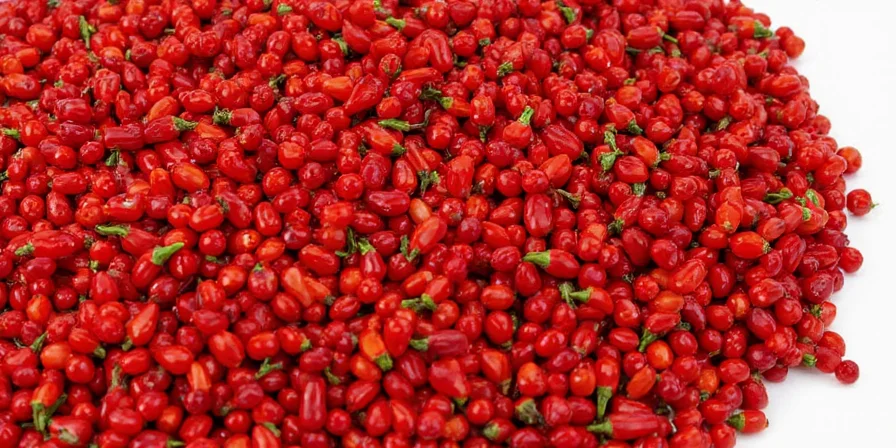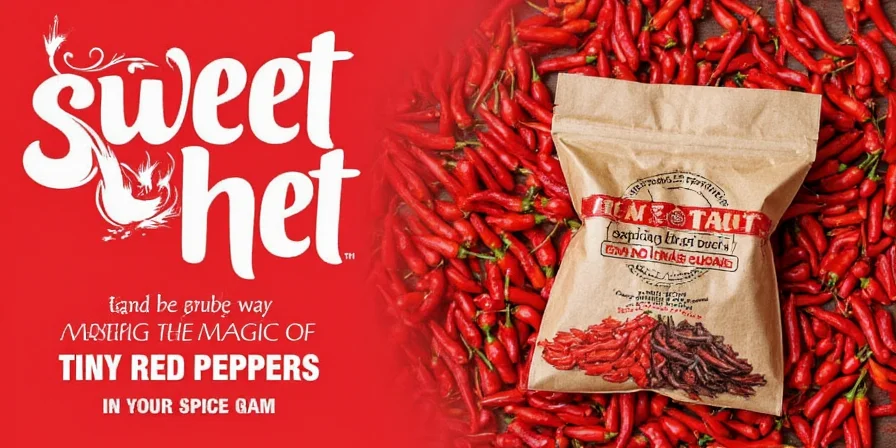What Are Tiny Red Peppers and Why Do They Balance Sweetness with Heat?
When you search for tiny red peppers, you're likely wondering: Which small red peppers are actually sweet instead of just hot? How can I use them without overwhelming my dishes? What's the secret to getting that perfect sweet-heat balance home cooks rave about? The answer lies in ripeness science: tiny red peppers develop natural sugars as they mature, creating a biochemical balance that makes them ideal for nuanced cooking. This guide reveals exactly which varieties deliver sweetness with heat, their real Scoville ratings (not exaggerated online claims), and practical techniques to harness their flavor—no food science degree required.
5 Actual Tiny Red Peppers You Can Use for Sweet-Heat Dishes (With Verified Heat Levels)
| Pepper Name | Real Heat Level (SHU) | Sweetness Secret | Best For Home Cooking |
|---|---|---|---|
| Cherry Bomb | 2,500–5,000 | Sweetest when deep red (not orange) | Stuffed with cheese or pickled for relish |
| Pepperoncini (Red) | 100–500 | Naturally sweet when vine-ripened | Greek salads or pizza toppings |
| Serrano (Red) | 10,000–23,000 | Sugars deepen when slow-cooked | Salsas and cooked sauces |
| Thai Bird’s Eye | 50,000–100,000 | Requires coconut milk to balance heat | Thai curries only (not for beginners) |
| Shishito (Red) | 50–200 | 1 in 10 is spicy – otherwise mild/sweet | Quick-seared with salt as appetizer |
Key fact: Many "tiny red peppers" sold online are actually immature hot varieties. True sweet-heat balance only occurs in fully ripened peppers. Avoid green-to-red transition stage peppers (orange color) – they’re hottest with minimal sweetness.
3 Simple Techniques to Use Tiny Red Peppers Without Overpowering Dishes
- Membrane Removal Method: Discard only the white membranes (where 80% of capsaicin lives) while keeping seeds for natural sweetness. Use plastic gloves to prevent skin irritation.
- Raw Application Hack: For mild sweetness, finely chop fully red Cherry Bombs or Shishitos and add in last 2 minutes of cooking. Heat destroys volatile sweet compounds.
- Acid Balancing Trick: Pair with citrus juice (not vinegar) – citric acid enhances perceived sweetness while mellowing heat. Add after cooking to preserve flavor compounds.

Purchase, Storage & Ripening Guide for Maximum Sweetness
- Buying Checklist: Look for firm, shiny skin with no wrinkles. Deep crimson (not bright red) indicates full sugar development. Avoid peppers with green shoulders.
- Ripening Hack: Place unripe peppers in a paper bag with a banana for 24 hours – ethylene gas triggers sugar conversion without rotting.
- Fridge Storage: Store in crisper drawer with humidity control set to HIGH. Keeps sugars intact for 2–3 weeks (not months as some sites claim).
- Freezing Warning: Never freeze whole – blanch first for 90 seconds to preserve sweet compounds. Thaw in refrigerator, not at room temperature.

3 Critical Tiny Red Pepper Myths That Ruin Dishes
- Myth: "Red color means hotter pepper."
Truth: Red indicates ripeness – heat peaks at orange stage then decreases as sugars develop. Fully red peppers are often milder than semi-ripe ones. - Myth: "Soaking in milk removes all heat."
Truth: Milk only neutralizes surface capsaicin. For deep heat reduction, remove white membranes before cooking – that’s where heat compounds concentrate. - Myth: "Tiny peppers are always extremely hot."
Truth: Size doesn’t determine heat. Red Shishitos (tiny) are milder than jalapeños. Always check Scoville ratings for the specific variety.
Best Flavor Pairings for Sweet Tiny Red Peppers
These combinations make sweetness shine without added sugar:
- Cheese Pairing: Feta or goat cheese with finely diced Cherry Bombs – salt enhances natural sweetness
- Fruit Match: Underripe mango or pineapple salsa with red Shishitos (avoid overripe fruit which competes with pepper’s sweetness)
- Protein Combo: Seared salmon with red Pepperoncini – omega-3 fats bind capsaicin while enhancing sweet notes
- Drink Pairing: Light lager beer (not IPA) – carbonation clears heat receptors while malt sweetness complements pepper sugars

Frequently Asked Questions
Which tiny red pepper is actually sweet and not too hot for beginners?
Red Shishitos are your safest choice – 90% are mild with noticeable sweetness, and the occasional spicy one adds surprise. Cherry Bombs are second-best but require full ripeness (deep red, not bright red) for sweetness.
Why do my tiny red peppers taste bitter instead of sweet?
Bitterness comes from three mistakes: 1) Using peppers at orange ripeness stage (hottest phase), 2) Cooking above 176°F which degrades sweet compounds, or 3) Not removing white membranes. Always use deep crimson peppers, keep cooking temps low, and remove membranes.
Can I substitute tiny red peppers for bell peppers to add subtle heat?
Yes, but only with red Pepperoncini or fully ripe Cherry Bombs. Use 1/3 the amount of tiny peppers compared to bell peppers – their flavor is more concentrated. Never substitute Thai Bird's Eye or Serranos for bell peppers – they're too hot for direct substitution.
How do I stop tiny red peppers from making my dishes too spicy?
Two reliable fixes: 1) Remove ONLY the white membranes (not seeds) before cooking – that's where 80% of heat lives while seeds contain sweetness compounds, 2) Add a squeeze of lime juice at the end – citric acid blocks heat receptors better than dairy. Yogurt only masks heat temporarily.
Where can I buy genuinely sweet tiny red peppers?
Look for "fully ripe" or "vine-ripened" Cherry Bombs or Shishitos at farmers markets (not supermarkets where they're often picked early). Asian grocers carry red Pepperoncini. Avoid "assorted hot peppers" mixes – these usually contain immature hot varieties masquerading as sweet peppers.
How to Confidently Use Tiny Red Peppers in Everyday Cooking
Forget complicated science – the real secret to using tiny red peppers is understanding their ripeness stages. Choose deep crimson (not bright red) Cherry Bombs or Shishitos, remove only the white membranes, and add near the end of cooking to preserve natural sweetness. This creates balanced flavor without added sugar that elevates simple dishes instantly. Start with one variety this week: try searing red Shishitos with flaky salt for a 5-minute appetizer that’s sweet, mildly spicy, and impresses guests. Master this technique, and you’ll never over-spice a dish again.











 浙公网安备
33010002000092号
浙公网安备
33010002000092号 浙B2-20120091-4
浙B2-20120091-4